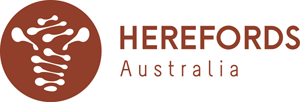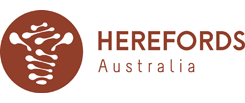Three teams of purebred Hereford steers have entered the 2017 NSW Beef Spectacular Feedback Trial.
The 112-day feedlot trial is conducted at Teys Australia’s Jindalee feedlot in southern NSW, drawing 75 teams of 375 cattle comprising 17 different breeds.
A team of five Hereford steers have each been entered by Vern, Margaret and Geoff Younger, “Bannockburn’’, Inverell; Ray and Michelle Cheers, Goolgowi, NSW and Greg Tyler, Hill View Herefords, Dorrigo, NSW.
With target carcase exit weights of 370-400kg, the steers will be processed at Teys Australia’s Wagga plant in early January with the winners announced at a presentation dinner later in the month.
Last year, the Younger family’s team placed eighth in the carcase and 23rd overall with an average daily gain of 2.6kg.
The steers had an average carcass weight of 407kg, with a dressing percentage of 56.9, 24mm of P8 fat, an eye muscle area of 86sqcm, and 67.8 per cent saleable meat yield.
Vern and Geoff recently attended a field day at the feedlot to see the progress of their steers in the 2017 trial.
Based on Line One genetics for over 15 years, the commercial herd normally finishes steers off grass to Wingham Beef Exports at 350-380kg carcase weight.
Last month, the family sold a line of 56 grass fed steers, aged 24 months and averaging 343kg carcase weight, to return an average of $2195.
The consignment achieved 100 per cent compliance, with an average MSA Index of 61.4, 100 per cent grading marble score one to three, and with an average fat depth of 17mm.
Geoff said the feedback from the 2016 trial was used to fine-tune this year’s entries.
He said entry weights for the winter 2015-drop steers were lighter after penalties were received for the heavy exit weights in the 2016 trial.
“High growth and carcase weight needs to be balanced with fertility and calving ease,’’ he said.
“We aim to finish steers off grass to heavy weights as that suits our environment.’’
The Inverell property has heavy basalt soils and an annual rainfall of 700-750mm.
The family use AI across all 400 registered and commercial females, with the steers sired by imported US bulls.
Steers are finished on grazing crops of oats, forage sorghum and cowpeas plus natural grasses.
They are yard weaned over 10 days and educated to dogs and quad bikes.
Geoff said temperament, weight gain and carcase quality were the advantages of the breed.
“The Line One cattle are popular for their carcase quality, and predictability and evenness of the herd,’’ he said.
“They have low birth weight and calving ease combined with growth and marbling off grass.’’
As the next generation breeder, Geoff aims to eventually build commercial herd numbers and maintain the breeding focus of temperament, calving ease, weight gain and carcase quality.
“The results from the 2016 Spectacular Feedback trial showed our cattle had an average daily gain of up to 3.01kg in the feedlot – we have no trouble with weight gain and that’s where the profit is as we are all paid on weight,’’ he said.





